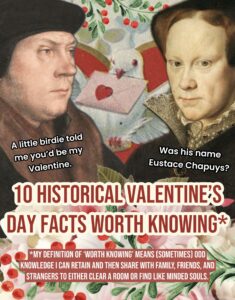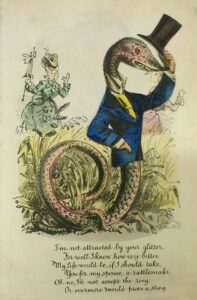 I love knowing random facts, so for Valentine’s Day I put together 10 historical facts about the holiday I feel are (odd enough to be) worth knowing*. These are a hodgepodge of historical facts, several coming from Victorian era articles and so the dates of some of these traditions are unclear. Let’s focus more on what they did. Because wow. The egg one will probably take your breath away (you’ll see why). I hope you’ll enjoy the read!
I love knowing random facts, so for Valentine’s Day I put together 10 historical facts about the holiday I feel are (odd enough to be) worth knowing*. These are a hodgepodge of historical facts, several coming from Victorian era articles and so the dates of some of these traditions are unclear. Let’s focus more on what they did. Because wow. The egg one will probably take your breath away (you’ll see why). I hope you’ll enjoy the read!
*My definition of ‘worth knowing’ means odd knowledge I can retain and then share with family, friends, and strangers to either clear a room or find like-minded souls.
- More sour than sweet! So-called vinegar Valentine’s Day cards packed an acidic punch to the recipient’s self esteem. In the 1800s when Valentine cards grew in popularity, the anonymity of the mail allowed for some pretty nasty cards to be sent. Compare this to modern trolling in comments, only with cuter graphics. One example roasts a doctor, not so subtly implying that an undertaker deals with most of his patients. Another card also worthy of a 💀☠️ emoji is of a lady walking her dog under the face of the moon. Not too bad right? Well, the text adds that the moon is the only man who smiles upon her. Told you. 💀

From Wikimedia Commons. This vinegar Valentine from the 1870s reads: “I’m not attracted by your glitter, For well I know how very bitter My life would be, if I should take, You for my spouse, a rattlesnake, Oh no, I’d not accept the ring. Or evermore ‘twould prove a sting.” Yikes!
. - Bay leaves for the win. Women wishing to dream of their Valentine-to-be, might place bay leafs on the corners of their bed and one on their, umm, ‘duckies’* because obviously this was a swell idea and bay leafs, ahem laurel leaves, are for winners. This tradition must have been well practiced, because a similar version existed, only the bay leaves were placed on the corners of the pillow and one in the centre (of the pillow not the lady). *Duckies: Tudor slang for breasts.
. - Stinky, crunchy mess. The Victorians had some fascinating ways to find out who their spouse or Valentine might be. This one caught my eye and made me laugh aloud (thankfully, in the comfort of my own home, so no eyebrows were raised in my direction). To find their true love, (and help out the ol’ bay leaves ritual), folks could hard boil an egg, fill it with salt (how? I have many questions…), then eat it. No, not just the egg, the shell too. But wait, there’s more. No talking or drinking anything, just curl up and sleep à la eggie. I wonder if the calcium in the shell was good for the teeth? Or if the dragon breath in the morning might highlight the most loyal of Valentines? Anyway, bon appetit, no? No.
. - More than a day of love. Valentine’s Day of the past, in some areas such as Norwich, England, had a tradition of leaving presents on doorsteps the eve before St. Valentine’s Day. Not only sweets, but toys like rocking horses and fishing rods. Gifts were left anonymously and advertisers would promote their products weeks in advance! The last bit sounds a bit like modern Christmas, only advertisers now promote their products months in advance.
. - Not only for Christmas! If you read the holly and the ivy and your mind starts up with that Christmas carol, you’re not alone. However, in the past, these plants had a role in Valentine’s Day too. In Kent, England there was a tradition of burning these on St. Valentine’s Day. Girls were said to burn a holly boy and boys, not to be left out, would burn an ivy girl in return. Isn’t young love sweet? Or maybe just hot…temperature wise. It was still February so maybe it was a tradition built on necessity? Anyway, it was done with loving intentions so I think it was less creepy and more cutesy romantic (different times).
. - A kiss under the mistletoe. If you think mistletoe is unique to Christmas you’d be mostly right, unless you time traveled back in time and then you’d be mostly wrong. In a Victorian-era article, a poem asks (in a much lovelier, fanciful way) why should kissing under the mistletoe be limited to Christmas? It continues stating it should be embraced all year long! Muah!
. - A passing fad. Valentine’s Day lost popularity in the 1890s and it was thought by some that it would be a holiday lost to time! No spoiler alert needed. Valentine’s Day survived! The skeptics should have known, love never dies…(or tomorrow, for the James Bond fans).
. - Clay balls for love. Fancy knowing the name of your Valentine? There was once a tradition to write the names of any romantic prospects and enclose each paper in a ball of clay. The balls would be put into a vessel of water and whichever name floated to the surface was thought to prophesize which Valentine would be delivering your sweets ‘on the morrow’.
. - Penny for your thoughts and your mail. Valentine gifts and tokens of affection were given long before ‘put a stamp on it’ postal service, with early Valentines surviving from the 15th century. The widespread thrill of sending and receiving Valentine’s Day cards really took off when the Penny Post of Great Britain and Ireland came into effect in 1840. This allowed people to send mail inexpensively and the recipient would no longer have to pay to receive mail as long as it was prepaid. Imagine paying to receive a vinegar Valentine. Talk about a sting!
. - Keep your enemies close and your Valentine’s closer. Thomas Cromwell was Lady Mary’s (future Queen Mary I) Valentine! In 1537, Cromwell sent Mary £15, which according to The National Archives currency converter would be about £6.5 thousand in modern currency. Or enough to buy 3 horses or 12 cows (Yes, I had to include the farm animals conversion.). Though it may be interesting to speculate here, historian and Thomas Cromwell biographer, Diarmaid MacCulloch says this gift giving was more symbolic in nature, with Cromwell acting as a sort of second father than anything romantic. (MacCulloch, page 352)
There you have it! A mashup of interesting historical facts about Valentine’s Day. How many did you know? Please don’t try the egg thing.
Sources and further learning
Beattie, Sarah. “Victorian Valentines”. The V&A Blog website. Accessed February 2024. https://www.vam.ac.uk/blog/caring-for-our-collections/victorian-valentines
Davies, Amy. “A Tudor Valentine’s Day”. The Shakespeare Birthplace Trust website, published February 14, 2021. Accessed February 2024. https://www.shakespeare.org.uk/explore-shakespeare/blogs/tudor-valentines-day/
Gendreau, Bianca. “Words of Love: Valentines of the Victorian Era.” Canadian Museum of History website, published February 13, 2015. Accessed February 2024. https://www.historymuseum.ca/blog/words-of-love-valentines-of-the-victorian-era/
Holt, Ardern. “Valentines”. Girl’s Own Paper, 1882. Accessed from VictorianVoices.Net website, February 2024. https://www.victorianvoices.net/ARTICLES/GOP/1882/1882-Valentines.pdf
K.M.H. “Holly and Mistletoe.” Demorest, 1870. Accessed from VictorianVoices.Net website, February 2024. https://www.victorianvoices.net/ARTICLES/VT/1802-Holly.pdf
MacCulloch, Diarmaid. Thomas Cromwell: A Revolutionary Life. New York: VIKING, 2018.
Natalia. “Love Stinks and So Do You: Victorian Valentine’s Most Vile”. The Toronto Reference Library Blog. Accessed February 2024. https://torontopubliclibrary.typepad.com/trl/2019/02/love-.html
The National Archives website. “Currency converter: 1270 to 2017”. https://www.nationalarchives.gov.uk/currency-converter/ Accessed February 2024.
VictorianVoices.Net website. “Victorian holiday celebrations: Valentine’s Day.” https://www.victorianvoices.net/topics/holidays/Valentines.shtml Accessed February 2024.
Published February 13, 2024.
